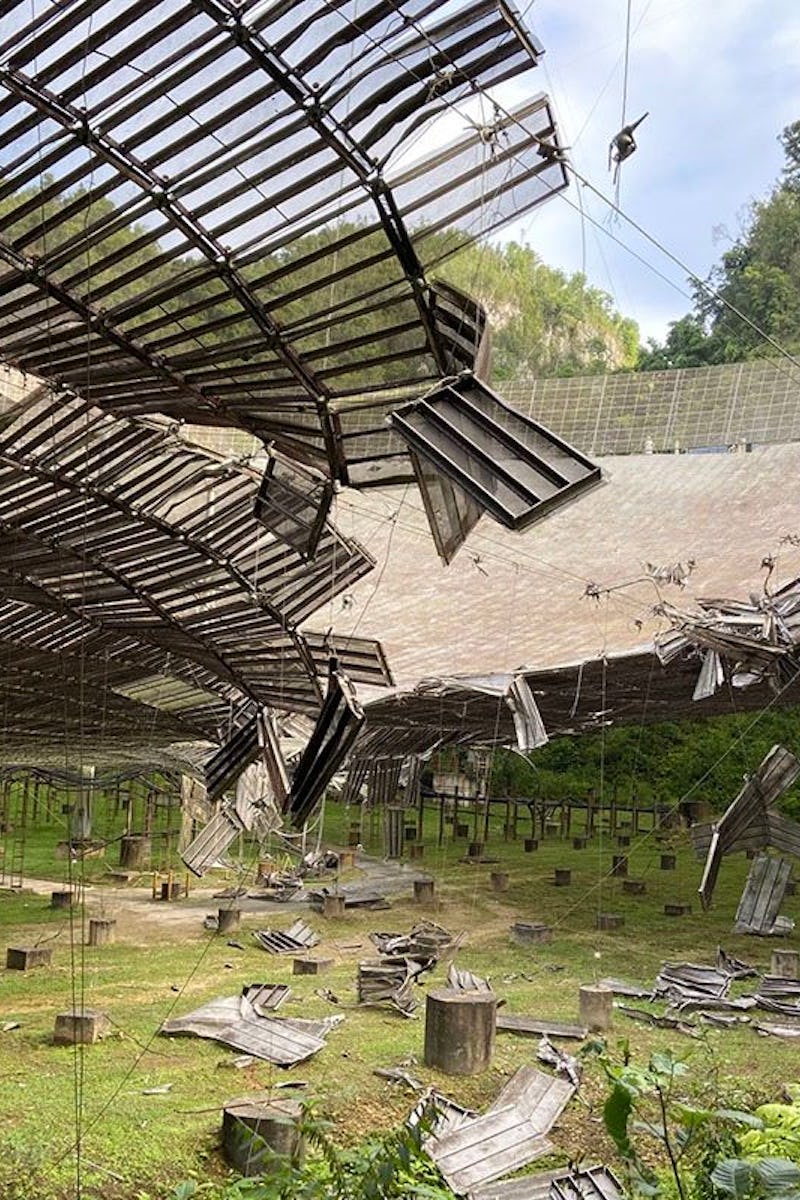
"There are no other facilities that could be used.
Arecibo: What happens after an iconic telescope is forced to go dark
The Arecibo Observatory suffered damage after a cable broke, forcing astronomers to put their research on hold.
by Passant RabieFor more than 50 years, the Arecibo Observatory has served as one of the world's most important lenses. It's looked out into the cosmos in search of potentially hazardous asteroids, and potentially habitable planets. It's tracked strange radio phenomena and potentially hazardous space weather.
However, on August 10 the Arecibo Observatory went dark after one of the large telescope's supporting cables snapped and crashed into its reflector panels. Engineers are still working to understand the damage and determine how long it will take for the telescope to be up and running once more.
Astronomers have been forced to pause their telescopic observations, and hundreds of research projects have been put on hold. It could be several months to a year's time before research reliant on Arecibo can begin again.
Constructed in 1963, the Arecibo Observatory was the world's largest telescope of its kind. Its reign as the biggest only ended in 2016 when China built the FAST radio telescope. Arecibo has a 1,000-foot long dish that spans over 20 acres in the municipality of Arecibo in Puerto Rico.
Its sheer size makes for more accurate, sensitive observations of the cosmos — and has made it famous in pop culture. The observatory was featured in Carl Sagan's novel Contact, the 1995 Bond movie Goldeneye, and an image of pulse waves captured by Arecibo made the album cover for Joy Division's Unknown Pleasures.
"There are no other facilities that could be used." — Over the course of its history, Arecibo has made major contributions to the field of astronomy, particularly in the study of habitability and near-Earth asteroids. In August 1989, the observatory directly imaged an asteroid for the first time in history.
In 1994, astronomers observing a pulsar star using Arecibo discovered evidence of the first exoplanet orbiting a star other than the Sun. In 2016, astronomers used the Arecibo Observatory to detect the first radio emissions from a brown dwarf star.
Anne Virkki is a research scientist at the Arecibo Observatory and serves as the leader of the Planetary Radar Science Group. She's been using the telescope to observe 100 to 200 near-Earth objects a year and determine their chances of hitting Earth.
"All observations are down right now," Virkki tells Inverse. "There are no other facilities that could be used."
On Monday, August 10, an auxiliary cable that was designed to last another 15 to 20 years suddenly broke and crashed into the radio telescope's reflector panels, tearing a 100-foot gash in the main dish.
“This was certainly an unprecedented event,” Francisco Cordova, director of the Arecibo Observatory, told reporters during a news conference on August 14.
The observatory has been shut down indefinitely, dimming one of the largest eyes on the cosmos. Observatory officials are still assessing the damage, but repairs could take from several months to a year as six to eight panels on the Gregorian dome had been damaged by the broken cable.
What is most concerning is that it is still not clear whether the instruments inside the telescope's dome were damaged as well, according to Cordova.
The damage sustained by the radio telescope as a result of the cable snapping, and falling onto the dome.
"We are a pretty resilient bunch." — Abel Mendez, a planetary astrobiologist and director of the Planetary Habitability Laboratory at the University of Puerto Rico, has been using the Arecibo Observatory for four years as part of his research on determining the impact of red dwarf stars on the habitability of their planets.
Until the telescope is up and running again, Mendez and his group will have to put their work on hold. No other facility can conduct the same type of observations.
"Arecibo is also a radar, capable of transmitting [radio waves.] Most radio telescope, such as the larger one in China [FAST], are only able to listen," Mendez tells Inverse. "Thus, Arecibo can make maps of planets and determine the orbit and size of potentially dangerous asteroids better than any other radio telescope in the world."
Similarly, the work being conducted by Virkki's group on near-Earth objects can only be done at Arecibo and the Goldstone Deep Space Communications Complex in California. That radio telescope is also currently under maintenance.
"We [Arecibo] are the most powerful and sensitive planetary radar in the world," Virkki says. "We have some special capabilities, the images we can get are completely unparalleled, unless there’s a spacecraft sent to a specific target, we can get these very fine images of tens of objects every year."
The Arecibo Observatory also suffered severe damage during Hurricane Maria, the repairs from which were still ongoing. On September 21, 2017, high winds caused the telescope's line feed to break and fall onto the primary dish, damaging about 30 out of 38,000 aluminum panels.
"The observatory has had a lot of opportunities over the years, and this is just another bump in the road," Cordova said. "We are a pretty resilient bunch."
Meanwhile, the researchers at the observatory are remaining cautiously optimistic regarding the state of their projects.
"I definitely hope that this damage gets fixed in about a year at the most," Virkki says. "If we get back up in a year, then things should continue as they were."